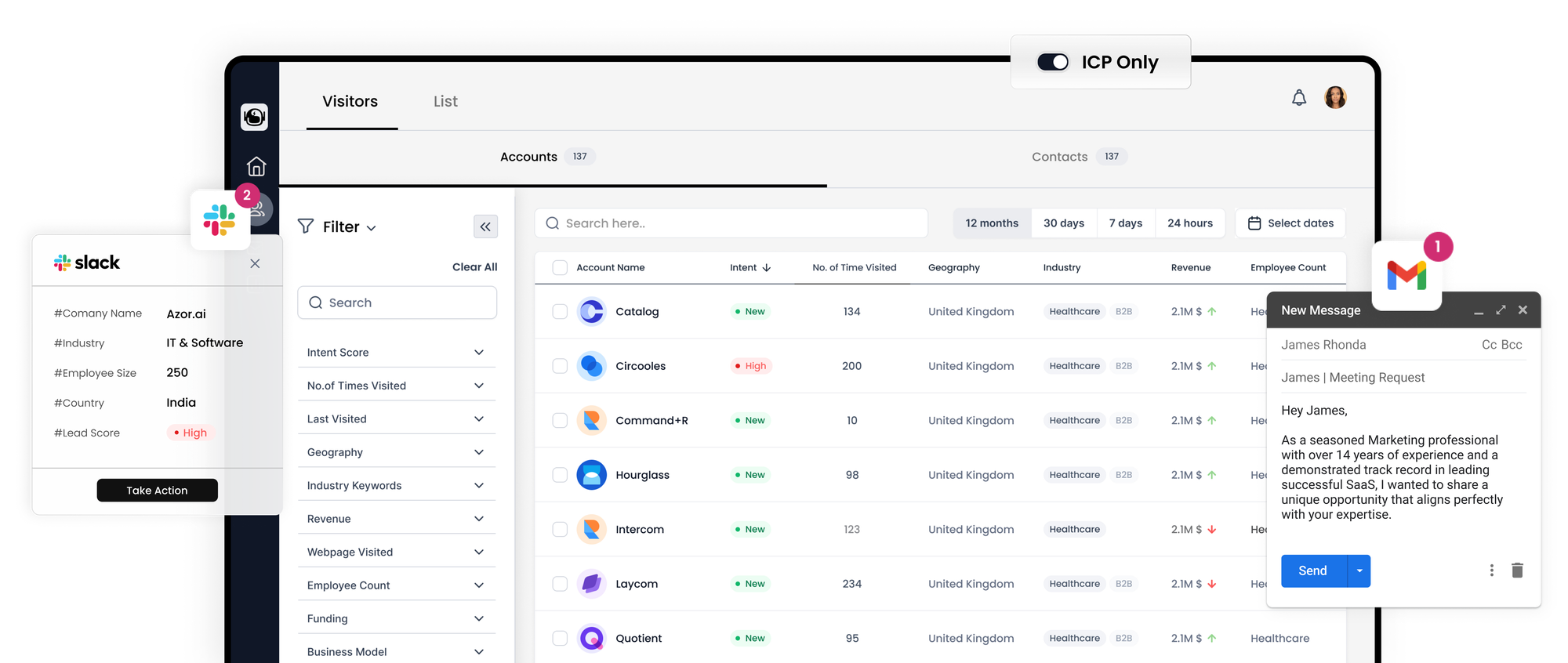Understanding Demand Generation in Marketing

Demand generation is a pivotal marketing concept that involves a strategic approach to cultivate interest and authority for your brand. It's about making potential customers aware of a problem they didn't know they had and positioning your product or service as the solution.
Here's a comprehensive look at what demand generation entails and how it operates within your marketing strategy.

Defining Demand Generation:
Demand generation is a holistic process focused on creating awareness and preference for your brand, ultimately leading to a desire for your offerings. This process is about educating the market, raising awareness, and generating interest.
For instance, if your business is selling nutritional supplements, demand generation might start with educating people about the importance of nutrition and how common diets often lack essential nutrients. By highlighting this gap, you create a need for your supplements.
Contrasting Demand Generation and Lead Generation:
Understanding the difference between demand generation and lead generation is crucial:
1. **Demand Generation:** It's the broader strategy encompassing various tactics to create interest in your brand. This includes activities designed to reach new audiences and excite existing ones about your offerings.
2. **Lead Generation:** This is a more specific, focused process. It involves converting the interest generated by demand creation into concrete leads, which means capturing contact information or getting prospects to take a specific action.
In simple terms, demand generation is about getting attention at the top of the sales funnel, while lead generation is about converting this attention into meaningful engagement.
How Demand Generation Functions:
Demand generation is a data-driven and comprehensive approach to create and maintain interest in your company’s products or services. Here’s a breakdown of its operation:
1. **Identify Your Target Audience:** The initial phase involves understanding who your potential customers are and their specific needs. This step is about audience segmentation based on factors like demographics and behaviors.
2. **Engage with Tailored Content:** Creating and distributing content that resonates with the identified audience is key. This content can vary from educational blog posts to interactive webinars, all designed to inform and engage your audience.
3. **Generate and Nurture Leads:** Through various marketing campaigns, generate leads and then nurture them through their buying journey. Nurturing strategies are crucial to keep potential customers interested and engaged.
4. **Qualify and Prioritize Leads:** Recognize that not all leads have the same potential. Employ lead scoring techniques to focus on prospects most likely to convert, helping your sales team to concentrate on high-value opportunities.
5. **Measure and Analyze Outcomes:** Finally, use metrics and analytical tools to gauge the effectiveness of your demand generation efforts. This step is vital for understanding what strategies work and making informed decisions for future campaigns.
In summary, demand generation is about creating a fertile ground for your brand’s growth by informing and engaging potential customers. It's a long-term strategy that focuses on building relationships and establishing your brand as a thought leader in your industry. By effectively implementing demand generation, you lay the groundwork for successful lead conversion and sustained business growth.
Advantages of Implementing Demand Generation Marketing
Demand generation marketing is a pivotal strategy for businesses aiming to expand their customer base and enhance their market presence. Here are some significant advantages of employing demand generation marketing:
1. **Enhanced Lead Quality:** Demand generation is about attracting high-caliber leads with a higher propensity to convert. This approach prioritizes quality over quantity, targeting prospects who genuinely require your products or services.
2. **Elevated Brand Awareness:** Utilizing a variety of marketing techniques, demand generation significantly increases your brand's visibility and recognition. This heightened awareness means that potential customers are more likely to consider your business when they're ready to make a purchase.
3. **Boosted Customer Retention:** Demand generation goes beyond the initial sale, continuing to offer value to existing customers. This ongoing engagement can lead to repeat sales, cross-selling opportunities, and customer referrals.
4. **Revenue Growth:** An effective demand generation strategy drives sales by efficiently moving prospects through the sales funnel, directly contributing to an increase in revenue.
5. **Synergy Between Marketing and Sales:** Demand generation encourages a collaborative effort between marketing and sales teams, aligning them towards the shared objective of revenue generation.
6. **Shortened Sales Cycle:** Through educating and nurturing potential customers, demand generation can reduce the length of the sales cycle, as prospects become more informed about your products or services.
7. **Valuable Data Collection:** Demand generation tactics often involve collecting prospect data through forms, surveys, etc., providing crucial insights into your target market's preferences and behaviors.
8. **Predictable Lead Flow:** A well-structured demand generation strategy can generate a consistent and predictable flow of leads, aiding in effective business planning and forecasting.
9. **Cost Efficiency:** Although there's an initial investment, targeting high-quality leads typically results in a lower cost per acquisition, making demand generation a financially sound strategy.
10. **Market Expansion Potential:** Demand generation campaigns can be scaled or adapted to tap into new markets, facilitating business growth and expansion.
B2C vs. B2B Demand Generation: Key Differences
Understanding the distinction between consumer (B2C) and business (B2B) demand generation is crucial due to their differing priorities and decision-making processes.
- **Consumer Decision Making:** Consumers, whether individuals or families, often make spontaneous decisions based on immediate needs or desires. They are more susceptible to traditional advertising and emotionally-driven content.
- **Business Decision Making:** In contrast, businesses operate with specific plans and objectives. Any product or service must align with their broader goals and strategies. Business decisions often involve multiple stakeholders and require a more analytical approach.
- **Messaging and Content Strategy:** Given these differences, the approach to messaging and content also varies. B2B communication tends to focus on professionalism, detailed data, and industry jargon. In contrast, B2C marketing might leverage authenticity, emotional appeal, and user-generated content to resonate with individual consumers.
In summary, demand generation marketing offers substantial benefits for both B2B and B2C sectors, though the strategies and tactics employed in each case will differ significantly to align with their respective audiences.
Incorporating Inbound Marketing into Demand Generation
Inbound marketing plays a pivotal role in demand generation. It's all about creating a welcoming atmosphere for potential customers and delivering experiences that not only meet their expectations but exceed them. This customer-centric approach involves crafting tailored messages and solutions that resonate with your audience, rather than a generic, widespread marketing blitz.
The essence of inbound marketing lies in attracting the right customers to your business and engaging them with content that addresses their specific pain points. By doing so, you establish a relationship where they view your business as a key player in solving their problems. This approach nurtures trust and fosters long-lasting relationships, making customers feel valued and part of your business's success story.
While inbound marketing is a crucial aspect of demand generation, it's not the sole element. It functions as a key strategy within the broader scope of demand generation efforts.
Effective Demand Generation Tactics
To harness the power of demand generation effectively, whether in a B2B or B2C context, certain strategies have proven to be particularly effective:
1. **Inbound Marketing Excellence:** As previously mentioned, inbound marketing is about respecting and valuing the customer. This involves crafting customer personas to understand and target your ideal audience effectively. Utilize social media and other digital platforms to engage and capture the interest of these potential customers.
2. **Establishing Authority:** Position your brand as a leader in your industry by sharing expertise and knowledge. Partner with complementary businesses for joint ventures like sponsoring events or participating in panels. Create and share high-quality content, including insightful articles, white papers, and webinars, to demonstrate your expertise and thought leadership.
3. **Offering Free Resources:** Providing valuable resources at no cost is a great way to showcase your expertise and attract potential customers. Whether it’s informative materials, useful apps, or educational content, these free offerings can reduce barriers and encourage engagement with your brand.
4. **Engaging Competitions:** Organizing competitions can create buzz and positive brand awareness. While the direct aim is contest participation, the underlying goal is to attract visitors to your site, encourage sign-ups, and ultimately drive sales.
5. **Leveraging Customer Testimonials:** Encourage satisfied customers to share their positive experiences. Authentic testimonials can significantly influence potential customers, showcasing real-life satisfaction and trust in your products or services.
In summary, demand generation is about strategically positioning your brand in the marketplace. It involves a blend of inbound marketing, content authority, and engaging tactics like free resources and competitions. The goal is to be seen not just as a vendor, but as an indispensable resource in your field, similar to how brands like Kleenex, Xerox, and Netflix have become synonymous with their respective industries.
Metrics and KPIs for Assessing Demand Generation Success
Measuring the success of demand generation activities is crucial to understand their effectiveness and ROI. Here are essential metrics and KPIs that can help gauge the success of your demand generation efforts:
1. **Marketing Qualified Leads (MQLs):** These leads have engaged with your marketing efforts and are considered more likely to become customers compared to general leads.
2. **Sales Qualified Leads (SQLs):** These are leads that have been evaluated and approved by both marketing and sales teams as ready for the next stage in the buying process.
3. **Cost Per Lead (CPL):** This metric calculates the total cost of your marketing campaign and divides it by the number of leads generated, giving insight into the efficiency of your lead generation efforts.
4. **Cost Per Acquisition (CPA):** This measures the average cost incurred to acquire a new customer, crucial for understanding the financial impact of your demand generation strategies.
5. **Customer Lifetime Value (CLV):** Predicts the total net profit attributed to the future relationship with a customer, helping in long-term business planning.
6. **Return On Investment (ROI):** Measures the profitability of your investments by calculating the net profit and dividing it by the total investment cost.
7. **Close Rate Per Channel:** This metric analyzes the effectiveness of different marketing channels by measuring the percentage of leads from each channel that result in sales.
8. **Marketing Cycle Length:** Understanding the average time it takes for a lead to convert into a customer post initial engagement is vital for optimizing marketing strategies.
9. **Average Deal Size:** This tracks the average revenue generated from each closed deal, offering insights into the value of your sales efforts.
10. **Contribution to Total Revenue:** Determines the proportion of total revenue directly attributable to marketing efforts, highlighting the impact of marketing on overall business success.
In today's data-driven world, tracking user engagement on your website and refining your strategy based on the content they find most useful is essential for continuous improvement.
Performance TV: Revolutionizing Demand Generation
Performance TV is redefining demand generation by turning connected TV (CTV) into a dynamic marketing tool. This approach enables marketers to reach audiences more effectively on streaming platforms, utilizing data for precise targeting and continuous strategy refinement.
Performance TV offers several advantages:
- It capitalizes on the growing trend of streaming, accessing diverse and engaged audiences.
- It provides precision targeting capabilities, allowing for tailored content delivery.
- It combines the reach of traditional TV advertising with the specificity and adaptability of digital advertising.
- It facilitates immediate traffic generation to your website, reducing friction and enhancing lead conversion.
- It leverages programmatic media buying technology for campaign optimization, aligning with specific campaign goals and KPIs.
Performance TV, therefore, merges the strengths of digital and TV advertising, providing an omnichannel approach that ensures consistent audience engagement across devices.
Concluding Thoughts on Demand Generation
For businesses committed to effective demand generation, exploring solutions like MNTN's Performance TV is a strategic move. As a leader in this domain, MNTN offers software solutions that are essential for developing and executing successful demand generation strategies, ensuring real, measurable results. By embracing innovative approaches like Performance TV, businesses can enhance their demand generation efforts, leading to increased brand awareness, high-quality leads, and ultimately, business growth.
